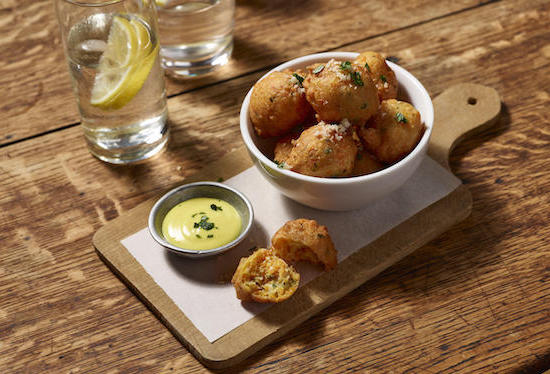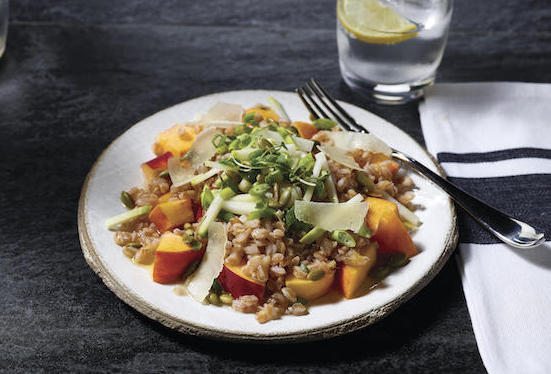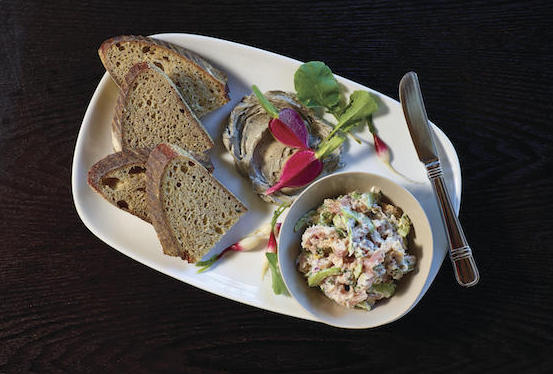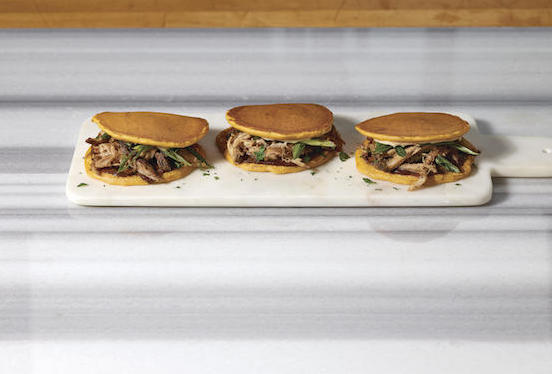Walk into the sun-drenched lobby restaurant of the Ace Hotel in Chicago, and you’ll find tables filled with hip locals and even hipper out-of-town guests wanting to see and be seen at the West Loop hot spot across from Google’s Chicago headquarters. Step out onto the fire-pit-warmed patio, and the cool quotient ticks up even higher. But City Mouse, the restaurant that operates both spaces, is more than just a perch for the pretty clientele. Power chefs Pat Sheerin, Jason Vincent and Ben Lustbader’s thoughtful, seasonal all-day menu features hearty offerings that go beyond a quick midday bite.

“We wanted a menu that people can enjoy all day,” says Sheerin. “We wanted things that were delicious and interesting, but still checked off boxes for guests that might want to keep it healthy. But we also wanted to weave in dishes we like as chefs.” With breakfast, lunch, dinner and event menus coming out of the busy kitchen, the all-day menu fits seamlessly into the mix. “Instead of having to go from a breakfast to a lunch and dinner menu and having to stop and pause all day and figure out a new mise en place, we have things that will naturally flow and progress through the afternoon,” Sheerin notes.
All-day greens
To Sheerin and his team, that means salads that strike a chord between hearty and heavy, like the vegan Caesar salad dense with kale, little gems and chickpeas and lightly dressed with a miso vinaigrette. The peach, kohlrabi and ginger farro salad with Pecorino is also satiating enough to hold guests over between meals, but not fill them up if they check in at an off-hour (US$12, recipe).
This story originally appeared in HOTELS’ sister publication Plate Magazine.
“It’s been popular for people to start with at brunch, because there’s not a ton of really savory or harsh notes of garlic or onion, so it’s easy on the palate,” Sheerin says. “But it also works really well later in the afternoon. There’s something fun and classically driven about a fruit-based salad with savory elements and a lot of pop and acid.”

Sheerin likes toasted farro for its smokiness and chew and pumpkin seeds for crunch, but he switches out the fruit and herbs as the seasons change. Ripe peaches turn to verjus-poached and roasted pears in fall, kohlrabi swaps out for turnips in winter and cilantro takes the place of coriander seeds or blossoms. “They let cilantro go to seed so you get fresh, green coriander seeds, which have a super-intense cilantro flavor but are a little more citrusy,” he says. A ginger-vinaigrette dressing pulls it all together and reminds Sheerin of the high-acid, high-sugar and heat found in a lot of Southeast Asian cooking, “similar to the umami hit of som tum,” he says.
Spread the love
It might be the oversized leather couches, vintage newspapers encased in glass coffee tables or industrial light fixtures throughout the space (a former fire station), but The Apparatus Room in the Detroit Foundation Hotel is another all-day restaurant pretty enough to entice guests and locals alike. They gather for Thomas Lents’ perfectly portioned all-day menu, which includes avocado toast with sumac, radishes and burnt grapefruit, and beef tartare with caper and golden raisin espuma. “We wanted a downtown destination where people can come at different times of the day and still get something great to eat without any real commitment to a full dining experience if that’s not what they wanted,” says Lents. His hearty whitefish salad served with heritage wheat bread more than fits the bill, offering a local touch at the same time (US$7, recipe).

“Being from Michigan, one thing that is always very nostalgic to me is the whitefish dip my parents made,” says Lents, who recalls watching fishermen catch and smoke whitefish on the beach during childhood vacations along the Michigan coast. As a kid, he ate the dip—made with lemon zest and juice, red onion, mayo, chives and dill—with Ritz crackers, but his grown-up version comes with housemade heritage wheat bread and charred scallion butter made with scallions he chars and blends in a coffee grinder before incorporating into high-quality French butter.
“We don’t use too much; it’s more of an aromatic than a flavor element,” says Lents. Brined local breakfast radishes (“the secret to a really great crudité is a light brine,” Lents swears) on the side add a sour bite to cut through the creamy dip that shows up on the lunch (in the form of a whitefish-salad sandwich), dinner and all-day menus. “I wanted to make sure it was a dish that translated across different time periods, roles and spaces in the restaurant,” he notes.
Portion Control
The same idea of dishes translating across time periods came into play when Darren Anklam developed the all-day menu at City Hall Bistro in Dallas’ 400-room Adolphus Hotel. “The main concept, being it’s in the lobby, is to encourage smaller portions, smaller plates, lots of sharing and interaction not only with the food but with the quartinos of wine,” explains Anklam, the hotel’s culinary director. “Whether it’s friends or business partners [meeting during the day], they can take advantage of tasting most of the menu, as opposed to a traditional appetizer, entrée and dessert.”
One of the best-selling bites that appears on every menu from breakfast through happy hour is the atayef, a three-bite Lebanese pancake stuffed with crispy duck confit, pear sauce and black garlic aïoli Anklam likens to a “pancake taco” (US$15, recipe). “It’s built for speed,” says Anklam, who was inspired to make the dish after he tried a sweet fig version at a party hosted by Middle Eastern friends. “All the components are ready to go, so when we’re in that mid-shift at 3 p.m. when we close for lunch and dinner, it’s something we can put together really fast and it tastes great.” Puréed piquillo peppers are added to the batter for heat and color, and the duck confit comes from thighs left over from a duck breast entrée. “We try to utilize everything from top to bottom,” he adds.
To make the snack even easier to execute, the small pancakes are griddled on a plancha into a sturdy, figure-eight shape. “Traditionally they’re done like a pocket; like a hot pocket, you just fold it over. I’d love to check into the hotel, grab a quick cocktail and have these as a pre-dinner snack,” says Executive Chef Jeramie Robison, who notes that while it sounds easy, it takes a strong kitchen team to pull off adding an all-day menu to an already busy hotel kitchen.
“Some chefs feel like it’s a beat-down,” he admits. “In a perfect chef life, you’d be closed Sunday and Monday and only open for dinner, but it’s a different beast to be creative and have one collaborative team that makes sure service runs well all day long.”
Michael Smulson and the team at Austin’s South Congress Hotel know what Robison is talking about. “The kitchen doesn’t stop at any time; there’s no break, so we just have to be organized, have great teamwork and communicate,” says Smulson, the chef of Café No Sé, the hotel’s casual café that serves as late as 10 p.m.
“The concept is an all-day café with lots of light, Mediterranean-inspired food, red and white quinoa bowls, fish,” he says. To pull it off, he relies on low-maintenance dishes like savory vegetable beignets, a signature created by opening chef Michael Paley that they change by the season. “They’re relatively easy to make and execute, and they’re good.”
In the warmer months, the restaurant does an English pea version with whipped feta and pickled Aleppo carrots, while fall calls for a sweet potato version with turmeric aïoli (US$8, recipe).
“We throw whole pieces of julienned potatoes into the batter, so you get a nice bite,” says Smulson. “They are fried, but they’re still nice and fluffy when they come out of the fryer.” Freshly grated turmeric is used in the aïoli to take full advantage of the flavor and health properties of the root, and it works well with the sweet potato for a snack available on the all-day, bar and even late-night menu by request. “Our goal is to please the guests, so we are open for anything they want,” he says.

Ultimately, what all weary travelers really want is something easy and delicious but light enough to keep their energy up while on the road. “Maybe the guest is here for work or business and their focus isn’t to have an extravagant meal,” says City Mouse’s Sheerin, who also offers a selection of delicious—but not gut-busting—sandwiches like a mushroom melt and a gas station sandwich with fixings like hashbrowns, eggs, sausage and grape jelly stacked on a small, housemade English muffin.
“Our all-day sandwiches aren’t eight-inch, two-pound hoagies, but they’re still delicious and well-made,” he says. “They’re on smaller bread so they aren’t overloaded. They should have balance and be crunchy and creamy, and have a little bit of acidity, but not be huge. I hate that feeling of being stuffed when you’re done eating.”
Same goes for those craving something sweet, but not wanting to commit to an energy-zapping dessert. The milk toast at City Mouse was originally inspired by Sheerin and Vincent’s taste memories of buttered cinnamon toast, but it now serves as an easily sharable sweet bite that works as a brunch entrée or late-afternoon treat. The griddled sourdough bread is covered with caramelized milk ganache, toasted pumpkin seeds, candied cashew-coconut clusters and apricot jam (US$6, recipe).
“We toast the bread on the griddle with butter until it’s golden brown and then sprinkle it with cinnamon sugar and brown it one more time so it has a caramel crust,” says Sheerin. “Instead of just having a side of toast with jam, we wanted to elevate it to be a little more chef-y and fun but really delicious.”
And it’s finding that perfect place between satiated and stuffed that will please the unpredictable hunger of any hotel guest. “It would be great if someone came in for a cup of coffee and pastry in the late morning, and is doing work and ends up hanging out for an hour or two and then wants something a little more hearty,” says Sheerin. “We want to make sure we can take care of everyone.
This story first appeared in HOTELS’ sister publication Plate Magazine.
